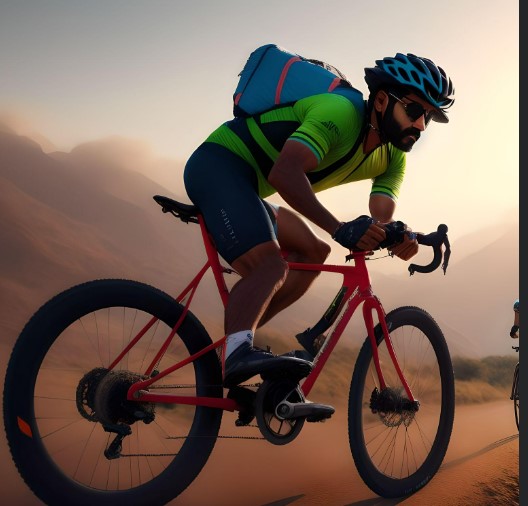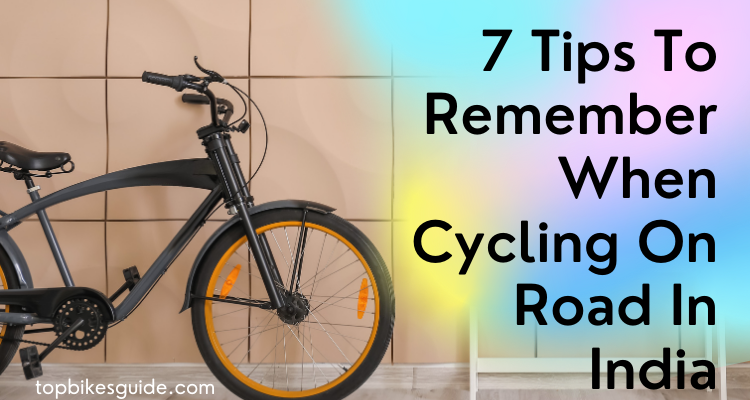Cycling is experiencing a surge in popularity in India, and it’s not hard to see why. It offers many benefits – not only is it a fantastic way to stay fit, but it’s also an environmentally friendly means of transportation that truly allows you to immerse yourself in India’s breathtaking landscapes. However, it’s crucial to prioritize road safety when cycling in India. Here’s how this blog post shares 7 Tips to Remember when Cycling on Road in India and in the bustling traffic
Understanding Indian Road Conditions
India’s vast and diverse road infrastructure presents challenges for cyclists. Traffic congestion, poor road conditions, and the lack of cycling lanes make cycling in India potentially hazardous. However, by being aware of these challenges and taking necessary precautions, cyclists can still enjoy India’s roads while prioritizing safety.
Essential Safety Equipment for Cyclists
India’s roads can be unpredictable, so staying alert and attentive while cycling is important. Knowing safe riding techniques such as proper signaling, lane positioning, and navigating busy intersections is also essential. Watch for common hazards such as potholes, animals, pedestrians, and unfamiliar road signs.

- Helmet: Always wear a helmet to protect your head in case of an accident.
- Reflective Clothing and Lights: Stay visible on the road day and night by wearing reflective clothing and using lights.
- Pads: Use elbow and knee pads for added protection if you fall off your bike.
- Mirrors: Equip your bike with a front mirror to monitor traffic conditions.
- Bell or Horn: Install a bell or horn on your bike to alert and signal other drivers of your presence.
7 Tips to Remember when Cycling on Road in India
Cycling on the roads in India can be a thrilling experience, but it is important to remember to stay safe. There are a few key tips to remember when cycling in India.
- Wear a Helmet: Wearing a helmet is crucial for road cycling in India. It protects your head from injury and can save your life. Invest in a quality helmet that fits well, and wear it always. Remember to replace your helmet every few years to maintain safety standards.
- Follow Traffic Rules & Signals: Always remember to follow traffic rules and signals when cycling on the road. Obey traffic lights, stop signs, and use hand signals to indicate turns and stops. Doing so will ensure your safety and the safety of others on the road.
- Be Aware of Vehicles: Be aware of vehicles on the road and stay alert. Always use hand signals to indicate your intentions to other drivers, and wear a helmet.
- Have Reflective Gear: Make sure you have reflective gear while cycling. Reflective gear like a vest or jacket will help increase your visibility to other drivers and keep you safe.
- Use Lights & Bells: Use Lights & Bells – Lights and bells are essential safety features for cyclists in India. Make sure to equip your bike with bright LED lights and a loud bell to alert pedestrians and other road users of your presence.
- Choose the Right Bicycle: Consider your riding style and terrain when choosing a bicycle. Ensure the bike has the right components and features for your needs. Look for a bike with a comfortable fit, durable frame, and reliable brakes.
- Know Your Rights as a Cyclist: It is important to know your rights and responsibilities as a cyclist. Make sure to familiarize yourself with your area’s applicable laws and regulations, and always ride with caution.
Dealing with Road Hazards
When cycling on Indian roads, being aware of potential hazards is important. Potholes, rough road conditions, and road debris can pose risks. Speed breakers, bumps, open drains, and construction zones should be cautiously approached. By staying vigilant and following these tips, you can have a safe and enjoyable cycling experience in India.
Communication and Signals
To have a safe and enjoyable cycling experience on Indian roads, it is important to use proper communication and signals. Hand signals for turning and stopping, verbal communication with motorists, eye contact, and limited use of honking are key. By following these tips, you can ensure a safe and enjoyable ride!
Tips for Long-Distance Cycling
Long-distance cycling can be enjoyable and rewarding but requires proper preparation and planning. Here are some helpful tips for cyclists planning a long-distance ride.
- Get Fit: To enjoy a successful long-distance cycling ride, you must prepare your body. Make sure to get into shape by doing proper warm-up exercises and stretches before each ride.
- Stay Hydrated: When riding long distances, staying hydrated is essential. Carry plenty of water and drinks, and take regular breaks to rehydrate.
- Get the Right Gear: You must invest in the right gear for long-distance cycling. A comfortable saddle, durable bike frame, and reliable brakes are essential for a safe ride. Make sure your bike is equipped with appropriate lighting systems, reflectors, and safety flags so you can be seen by other vehicles on the road.
- Plan Your Route: Before your ride, plan out your route. Consider the terrain and look for road closures or known traffic areas.
- Monitor Traffic: When cycling on busy roads, it is important to monitor traffic around you. Be aware of drivers who need to pay more attention or follow traffic rules. Keep an eye out for cars that may be speeding or swerving into your lane.
- Stick to the Rules of the Road: Follow all local traffic laws and regulations while cycling in India. This includes observing speed limits, signaling turns, and using bike lanes when available.
- Look After Your Bike: As you ride long distances, taking care of your bike is important. Regularly check for wear and tear on the tires, brakes, chain, and frame. Clean your bike after long rides and adjust your brakes as needed.
Dealing with Extreme Weather Conditions
Cycling in India can be enjoyable, but staying safe is important, especially during extreme weather conditions like monsoon season. Check the weather forecast, avoid cycling in heavy rain or lightning storms, and be cautious of slippery or flooded roads. Wear proper clothing, stay hydrated, and plan your route carefully. Use bright clothing and lights for safety in foggy or low visibility conditions. Follow these tips for a safe cycling experience in India.

Interacting with Motorists and Pedestrians
Cycling in India can be thrilling yet risky without proper precautions. Remember to share the road responsibly, obey traffic laws, and be aware of your surroundings. Stay calm when faced with aggressive drivers, and make yourself visible. Be mindful of pedestrians and fellow cyclists, giving them ample space. With these tips, you can ensure a safe and enjoyable cycling experience on Indian roads.
Conclusion
Cycling in India offers an exhilarating experience, but safety is vital. Follow these 7 tips for a safe and enjoyable ride: wear a helmet, check your bike, be attentive, follow traffic laws, use proper gear, stay hydrated, and take breaks. With preparation and knowledge, make the most of your cycling adventure in India.
Frequently Asked Questions (FAQs)
What is the rule of cycling on the road?
The rule for cycling on the road in India is always to stay alert and be aware of your surroundings. In addition to wearing a helmet, cyclists should invest in reflective gear, a headlight, and a taillight to make themselves more visible. It’s also important to obey all traffic laws and give pedestrians and other vehicles plenty of space.
On which side of the road should you cycle in India?
In India, cyclists should always ride on the left side of the road. This helps to ensure that cyclists are given enough space by other vehicles and that they are visible to pedestrians and drivers. It also gives cyclists a better view of oncoming traffic and potential hazards.
Which rule should we follow while cycling?
When cycling in India, it’s important to always abide by traffic laws and regulations. It’s also necessary to be aware of your surroundings and take precautions to ensure your safety. This includes wearing a helmet, investing in reflective gear or a headlight and taillight, and giving passengers and other vehicles plenty of space on the road.
How do I get confident in road cycling?
Practicing is the best way to gain confidence when cycling on the road. Start by riding on quiet roads and familiarizing yourself with the traffic rules in your area. From there, you can slowly increase the difficulty of your rides, such as challenging yourself with more difficult terrain or routes with more traffic.
What is Rule 74 in cycling?
Rule 74 is a safety rule developed by the British cycling organization Cycling UK. It states that cyclists should ride at most two abreast and only when there is enough space for other vehicles to pass safely. Cyclists should also stay in single file when passing other road users or approaching bends.
Do cyclists have to stop at red lights in India?
Just like any other vehicle, cyclists in India are obligated to comply with traffic laws. This includes stopping at red lights and stop signs, giving way to pedestrians when crossing the road or entering an intersection, and yielding to oncoming vehicles. Cyclists should also keep track of their speed to avoid collisions.
Which cycle is best for rough roads?
If you plan to ride on rough roads, such as gravel paths or cobblestone streets, you need a bike with sturdy tires and strong suspensions. Mountain bikes are designed specifically for this type of terrain, as they have wide tires with deep treads for grip and shock-absorbing suspension systems to keep you comfortable.
Should you cycle in the middle of the road?
Generally speaking, there are better options than cycling in the middle of the road. This can be dangerous, as it puts you at risk of being hit by oncoming traffic or other hazards like potholes. Instead, cyclists should ride toward the left side of the road with traffic.
Which cycle is best on the road?
The best type of bike to use on roads is a road bike. Road bikes are designed specifically for this terrain and provide superior speed, efficiency, and agility due to their lightweight frames and narrow tires. They also have lower handlebars than other types of bicycles, allowing riders to remain in an aerodynamic position while riding.
What are the rules for cycling in India?
In India, cyclists must follow the same road rules as other vehicles. This includes obeying traffic laws such as stopping at red lights and stop signs, riding in designated cycle lanes whenever possible, using appropriate hand signals to indicate turns or changes in direction, having a visible presence on the roads, and reducing their risk of being involved in an accident.
Is a helmet compulsory for cycling in India?
Yes, wearing a helmet is compulsory for cycling in India. Helmets are the single most effective way of reducing injuries sustained in an accident, and they provide superior head protection from impact. All cyclists must wear properly fitting helmets that meet or exceed safety standards set by the government.
What happens if you hit a cyclist with your car in India?
If a driver hits a cyclist with their car in India, they could be liable for damages if the accident was caused as a result of negligence. The driver may be held financially responsible for medical bills, lost wages, and any other expenses related to the injury sustained by the cyclist.

A passionate cyclist with an unwavering love for the open road and founder of topbikesguide.com . Energetic and dedicated, this enthusiast embraces the thrill of speed and the freedom of two wheels.

